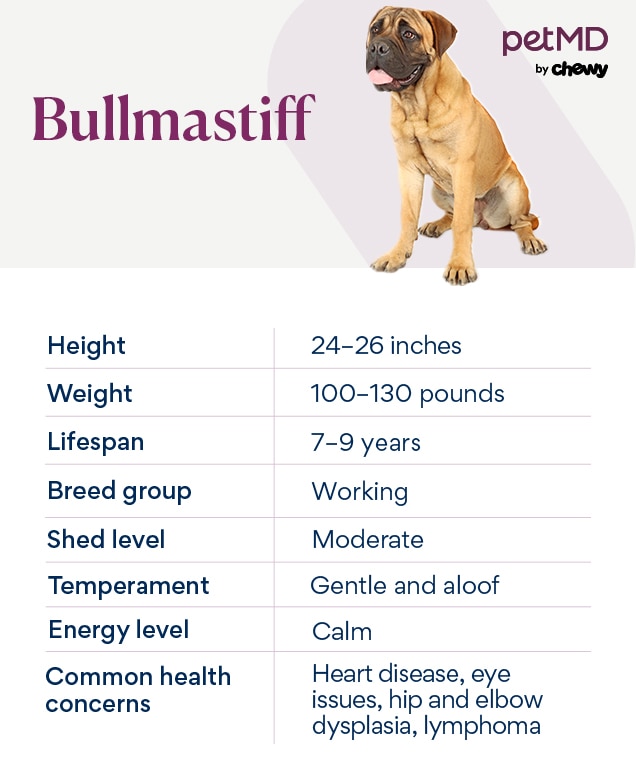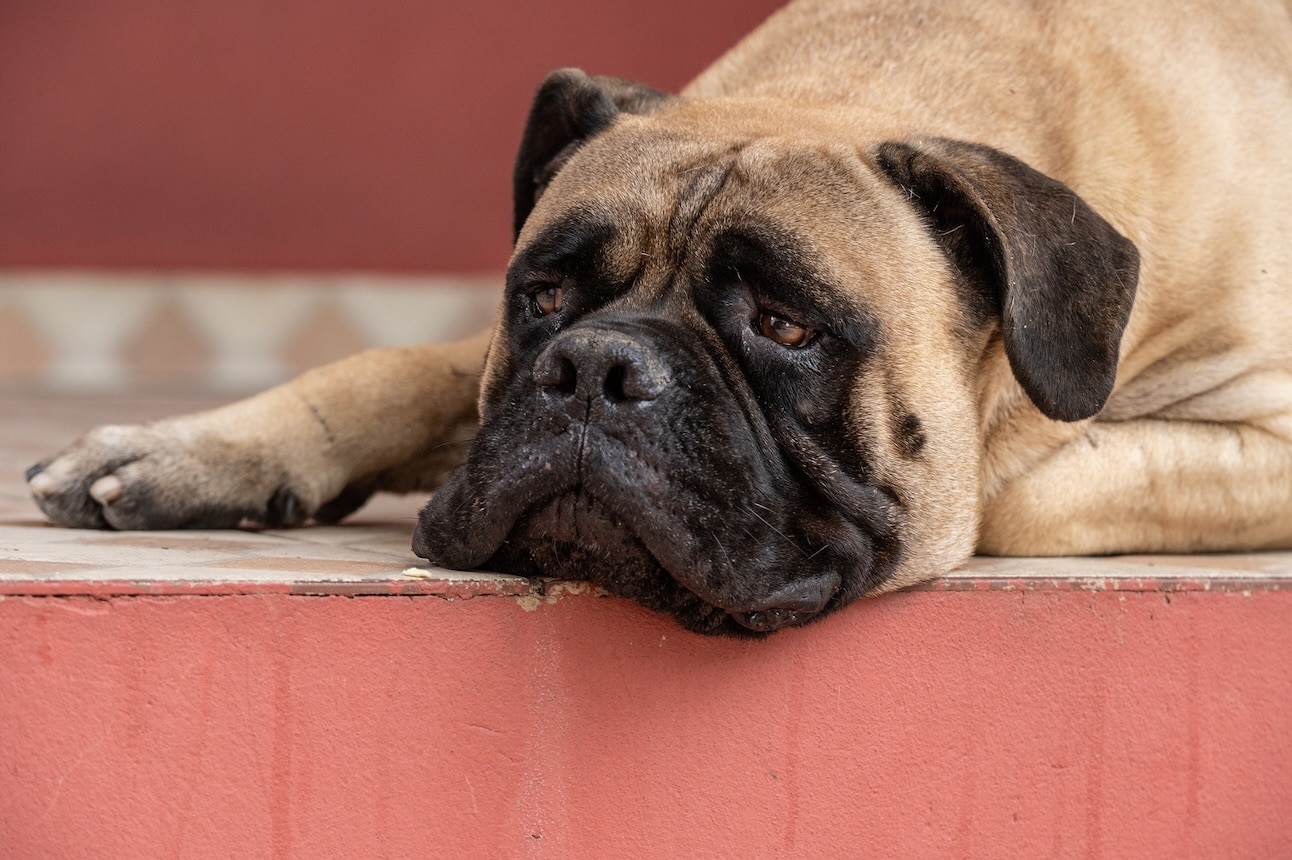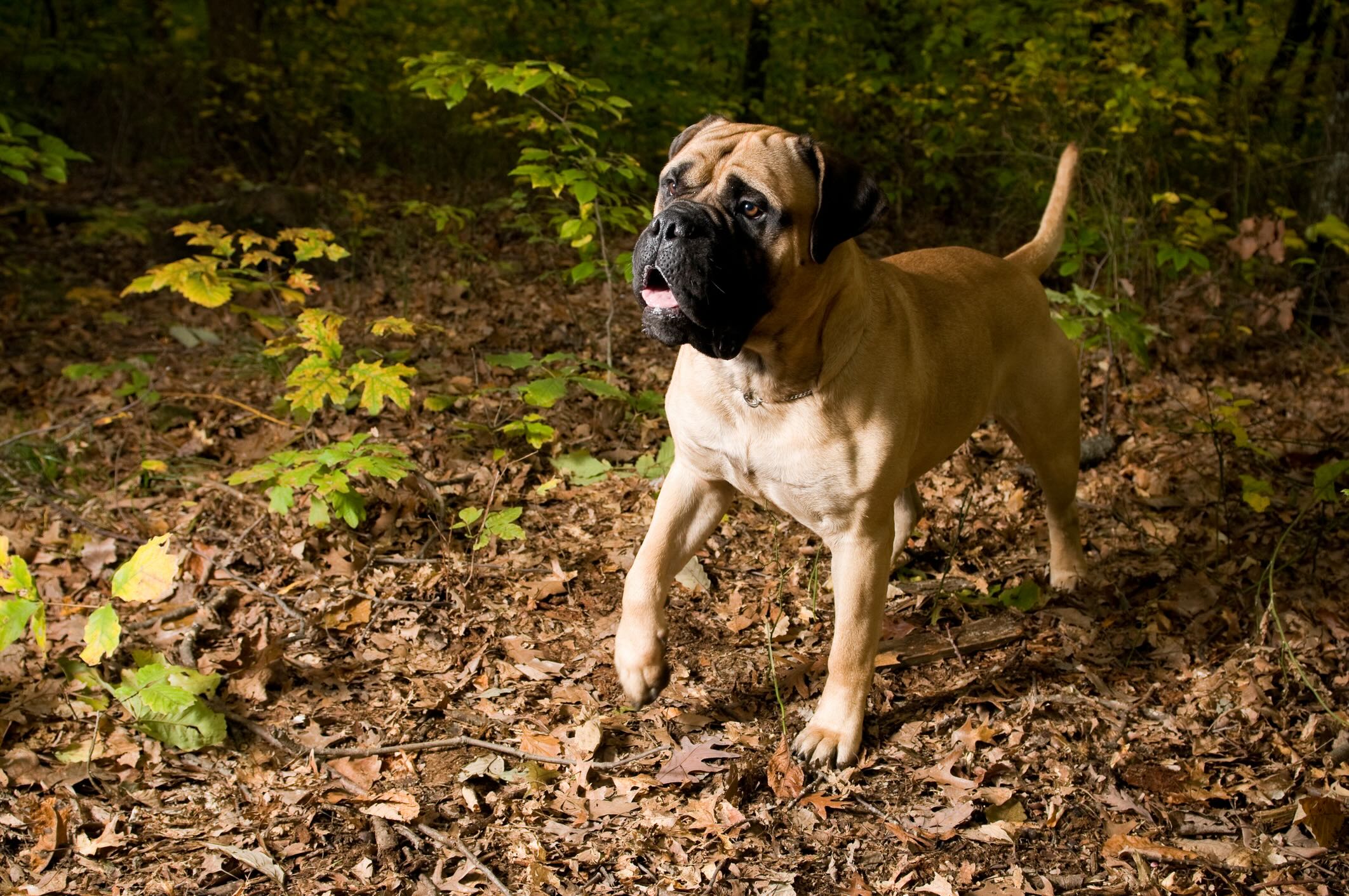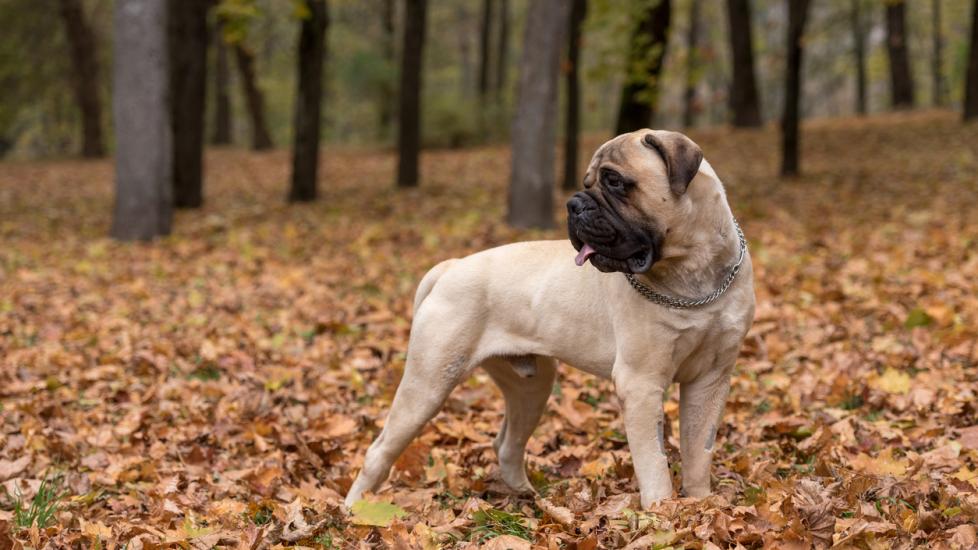Bullmastiff
iStock/White_bcgrd
The Bullmastiff is a loyal, affectionate, and giant dog breed.
According to the American Bullmastiff Association, British gamekeepers created Bullmastiff dogs by crossing Bulldogs with Mastiffs in 1860. Their goal was to create an extra-large dog who would listen well to cues and act as a guardian against poachers.
The Bullmastiff size is impressive—these dogs weigh 100–130 pounds and have a shoulder height of 24–27 inches, depending on their gender.
They’re known for their large, broad head; V-shaped ears; dark eyes; and muscular build. Bullmastiffs have a short, dense coat that can be one of three colors: fawn, red, or brindle.
Caring for a Bullmastiff

Bullmastiffs are docile and affectionate with family members, but they might take time to warm up to new people. They are good with young children and other dogs, though all interactions between kids and pets (no matter the breed) should be supervised.
Bullmastiffs are extremely intelligent dogs and usually learn quickly during training. However, it’s important for pet parents to train and socialize this breed early—Bullmastiff puppies have lots of energy and grow to become very strong, giant dogs that can easily knock people and children over if they lack training.
A Bullmastiff puppy needs to be trained to:
-
Remain calm around other dogs, adults, and children
Bullmastiffs need daily exercise, including long walks and playing within a fenced-in yard. But they don’t make good running companions because they don’t have the stamina to run long distances.
Bullmastiff Health Issues

The typical Bullmastiff lifespan is 7–9 years, as large dogs don’t live as long as smaller breeds.
They’re typically healthy dogs, but some health issues may pop up. Make sure to do your research when you’re looking for a Bullmastiff puppy and find a reputable breeder who screens their dogs for common health issues.
Dilated Cardiomyopathy (DCM)
Dilated cardiomyopathy (DCM) is a heart disease in Bullmastiffs that occurs when the heart muscles become weak and unable to pump blood properly. Bullmastiffs with mild to moderate DCM may show no symptoms, but severe DCM can include:
-
Rapid heart rate
-
Difficulty breathing
-
Collapse
-
Death
DCM is typically managed with medication.
Entropion
Entropion causes the eyelid to roll inward. When this happens, the eyelashes rub against the cornea (the eye’s surface).
This is a very painful condition that can lead to corneal ulcers. Surgery is needed to correct entropion.
Subaortic valvular stenosis (SAS)
Subaortic valvular stenosis (SAS) is a genetic heart condition that Bullmastiff puppies inherit from their parents. It develops during the first year of life, so responsible breeding is key to prevention.
SAS occurs when fibrous tissue slowly forms in the heart, obstructing blood flow. Over time, this causes the heart to stop functioning properly, resulting in heart damage.
Bullmastiffs with mild to moderate SAS may not show any symptoms. However, dogs with severe SAS:
-
Are lethargic
-
Will be tired after short periods of exercise
-
May collapse
-
Can die suddenly
Typically, mild cases of SAS require only monitoring and no treatment. In cases of moderate or severe SAS, your veterinarian may recommend medications to help regulate heart rate and increase heart efficiency.
Bullmastiffs with this condition need to be under a lifetime exercise restriction to minimize overworking their heart, which can lead to sudden death.
Progressive Retinal Atrophy (PRA)
Progressive retinal atrophy (PRA) causes the retina (the layer of an eye that detects light) to slowly degenerate, eventually leading to blindness.
PRA can be diagnosed with an eye exam and usually develops in young to middle-aged Bullmastiffs. There isn’t a cure.
Reputable Bullmastiff breeders will have their dogs’ DNA tested to see if they carry the genetic mutations for PRA. Dogs that carry these genetic mutations should not be bred.
Hip Dysplasia
Hip dysplasia is an inherited condition where the femur (thigh bone) doesn’t sit properly in the hip joint. As a result, the bone rubs against the hip socket, causing arthritis. Hip dysplasia can develop in one or both hip joints.
Though congenital hip dysplasia is rare, some Bullmastiff puppies are born with it. Others can develop this condition during their adult and senior years.
Symptoms include:
-
Slowness to rise from a lying position
-
“Bunny-hopping” gait when running
-
Reluctance to run, jump, or go up or down stairs
-
Holding the affected leg out to the side when sitting up
Hip dysplasia can be managed with joint supplements, weight loss, exercise, diet changes, and certain medications, but surgery may be needed in serious cases.
Elbow Dysplasia
Elbow dysplasia is an orthopedic condition that ultimately leads to degenerative joint disease within the elbow.
Pain is often detected when a veterinarian checks the range of motion in the elbow. X-rays or CT scans are the most common screening tests used for diagnosing this condition.
Surgery is often recommended, but mild cases can be supported with medications, joint supplements, and weight management.
Lymphoma
Lymphoma is a type of cancer that originates in the lymph nodes and typically spreads to other organs. Symptoms of lymphoma can include:
Treatment for lymphoma in dogs usually involves chemotherapy.
Bloat and Gastric Dilatation-Volvulus
Dogs with deep chests, including Bullmastiffs, are prone to bloat, a condition where their stomach fills up with gas and suddenly makes their abdomen distended.
Sometimes, bloat can lead to a life-threatening condition called gastric dilatation-volvulus (GDV), which occurs when a gas- or fluid-filled stomach twists and cuts off blood circulation to the stomach and other organs.
GDV is an extremely painful condition that can be fatal if emergency surgery is not performed immediately.
To minimize the risk of GDV in your Bullmastiff, ask your vet if your dog is a good candidate for a prophylactic gastropexy (stomach tack) procedure.
What To Feed a Bullmastiff

Bullmastiffs need a high-quality large- or giant-breed dog food. This is especially important for puppies, who need a large-breed food to support growth.
The food needs to be formulated for your dog’s life stage: puppy, adult, or senior. It also needs to meet the nutritional requirements set by the Association of American Feed Control Officials (AAFCO). Ask your vet for their advice when choosing dog food.
As with all dogs, their daily diet should consist of 90% dog food and no more than 10% treats.
How To Feed a Bullmastiff
Bullmastiff puppies need a large- or giant-breed puppy formula until they are 1 or 2 years old. Ask your vet when you should transition to a large- or giant-breed adult formula.
To minimize risk of bloat or GDV, the following recommendations can help at mealtime:
-
Feed your dog two or three meals a day instead of one.
-
Put the food bowl on the floor rather than elevate it.
-
If there are multiple dogs in the house, feed them separately to minimize stress.
-
Avoid exercise from one hour before to one hour after a meal.
-
Use a slow-feeder bowl, snuffle mat, or puzzle toy to prevent your Bullmastiff from eating too quickly.
How Much Should You Feed a Bullmastiff?
How much you feed your dog is based on their ideal body weight and life stage. It’s best to follow the feeding guidelines on the dog food packaging and consult your veterinarian to determine the proper portion to feed your Bullmastiff.
Measure out the food for each meal to ensure that you are feeding the proper amount.
Nutritional Tips for Bullmastiff
Because a full-grown Bullmastiff can weigh up to 130 pounds, some may benefit from joint supplements or an omega-3 fatty acid supplement (fish oil) for joint health. Always talk to your vet before giving your dog a supplement.
Behavior and Training Tips for Bullmastiffs
Bullmastiff Personality and Temperament

Bullmastiffs have a kind temperament around family members, including children. But they can become more reserved of new people in their home, which is why socialization during puppyhood is critical.
This breed has lots of energy, and training from an early age is important when caring for a Bullmastiff. This breed is very smart and learns quickly, so they do well in socialization classes, puppy training classes, and obedience training.
Bullmastiffs can also get along with other pets, but they must be socialized with them starting at an early age.
Bullmastiff Behavior
A gentle giant, Bullmastiffs generally have a calm temperament. They aren’t known to be anxious or fearful, but they can be uncomfortable around new people and animals without proper training and socialization.
Bullmastiffs are quiet dogs that are not known for excessive barking, though they will bark to alert their family when something seems out of the ordinary.
Bullmastiff Training
Bullmastiffs are quick to learn during training sessions. When trained as a puppy, a Bullmastiff will become a calm and well-mannered dog.
Training must be started when a Bullmastiff is young, because this breed can become strong-willed and more difficult to train as these dogs mature. Because of this, Bullmastiffs are best suited for experienced pet parents.
If you’re having trouble training your Bullmastiff, contact a certified dog trainer that uses positive reinforcement.
Fun Activities for Bullmastiffs
Bullmastiff Grooming Guide
Bullmastiffs have short, coarse fur that sheds seasonally. They don’t need much coat care, but because of their moderately drooly jowls, you might find yourself wiping drool from your floor and furniture as part of your cleaning routine.
Skin Care
Bullmastiffs don’t require a lot of skin care; they only need an occasional bath to keep them clean. Use a dog-safe shampoo.
Their jowls may need a daily wipe-down to remove excess drool or bits of dog food.
Coat Care
Aside from monthly brushing to reduce shedding, Bullmastiffs don’t need much coat care. They won’t need a professional groomer, and their short fur isn’t prone to matting.
Eye Care
Like many other dogs, Bullmastiffs can experience tear staining. Wiping their eyes with a vet-recommended tear stain remover can reduce discharge and stains.
Be alert for any changes in your dog’s eyes, which might indicate a health issue.
Ear Care
Bullmastiffs can develop allergies, which can make them prone to ear infections. Ear infections are often treated with prescription medications.
Ask your vet about how often you need to clean your dog’s ears with an ear cleaner; this can help prevent infections.
Nail Care
Just like with any other dog breed, a Bullmastiff needs frequent nail trims so the nails don’t break off or split. Grab your clippers whenever you hear your dog’s nails clicking across the floor.
Considerations for Pet Parents

The giant Bullmastiff is a loyal and affectionate dog. Their perfect home is one with older children and with a calm environment.
Pet parents should enroll their Bullmastiff puppy in training and socialization classes as soon as possible to allow them to become well-behaved around people and other pets. Bullmastiffs can become strong-willed and more difficult to train as they get older, so early training is key with this breed.
A fenced-in backyard is important for allowing this breed an area to run around in. Bullmastiffs might not do well in an apartment or small house.
Bullmastiff FAQs
How big does a Bullmastiff get?
Bullmastiffs weigh between 100–130 pounds, with males weighing on the higher end of this range. They stand 24–27 inches at the shoulder.
How long do Bullmastiffs live?
The typical Bullmastiff lifespan is 7–9 years.
How much does a Bullmastiff cost?
Typically, a Bullmastiff puppy will cost $1,000–$2,000. This price can rise if they are purchased from a reputable breeder who breeds dogs from champion lines.
Is a Bullmastiff a good family dog?
Yes, Bullmastiffs are sweet and loving to their family members.
References
Rishniw, Mark, and Kittleson, Mark. Aortic Stenosis. VIN.com. 2012. Revised by Beth Galles in 2022.
